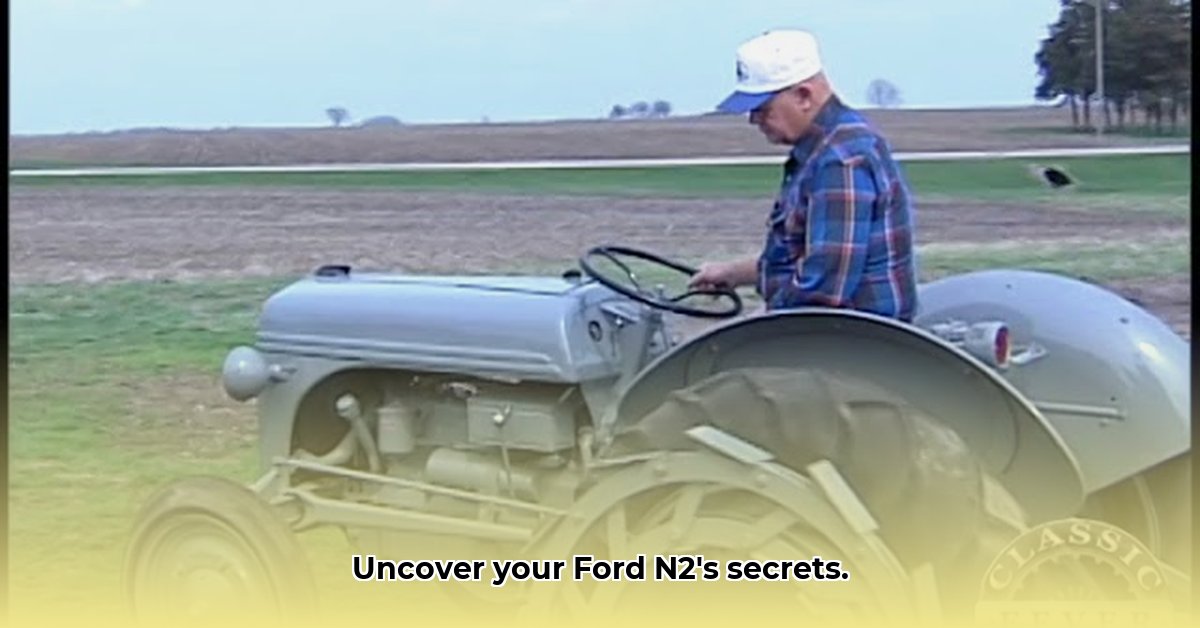
The Ford N2 tractor, a stalwart of American agriculture, represents more than just farm equipment; it's a piece of living history. This guide delves into the intricacies of identifying and restoring these iconic machines, catering to collectors, researchers, and enthusiasts alike. Whether you're deciphering the nuances of a 9N versus a 2N, or embarking on a meticulous restoration project, this comprehensive resource will prove invaluable. For additional resources, check out this helpful Ford N-series guide.
Identifying Your Ford N2 Tractor: A Detailed Examination
Pinpointing whether you possess a 9N, 2N, or even an 8N can be surprisingly challenging. These tractors, while belonging to the same family, underwent subtle yet significant design changes throughout their production. Wartime shortages, in particular, significantly impacted the 2N's construction. Instead of relying on a battery and alternator for ignition, many 2Ns utilized a magneto, a key distinguishing feature. Understanding these subtle differences is paramount. Did you know that even the location of the dipstick can offer valuable clues?
Key Visual Cues and Mechanical Differences
The following table highlights key differentiators between the 9N, 2N, and 8N models. However, remember that years of repairs and part replacements might obscure these distinctions. Always cross-reference your findings with additional resources.
| Component | 9N | 2N | 8N |
|---|---|---|---|
| Ignition System | Typically battery & alternator | Often a magneto (due to WWII material limitations) | Typically battery & alternator |
| Radius Arms | Usually I-beam shaped | Frequently tubular, but variations exist | Tubular |
| Dipstick Location | Commonly on the right side of the engine block | Location varies; use with caution as a sole identifier | Typically on the right side of the engine block |
| Paint Scheme | Typically grey (but repainting is common) | Typically grey (but repainting is common) | Typically grey (often with Ford script) |
Beyond these visual clues, the serial number, stamped on the tractor's frame, represents the ultimate identifier. This unique alphanumeric code reveals the tractor's manufacturing date and model, offering definitive identification. However, locating and deciphering these numbers can be demanding due to wear and tear. Using reliable online databases and resources is highly recommended.
Restoring Your Ford N2 Tractor: A Step-by-Step Guide
Restoring a vintage Ford N2 tractor is a labor of love, a rewarding journey into agricultural history. However, it's a project that requires meticulous planning and execution. Approaching the restoration systematically is critical for success.
Comprehensive Inspection: Begin with a thorough assessment of the tractor’s condition. Document all missing, damaged, or worn components. Photographs will be invaluable during the disassembly and re-assembly phases.
Parts Acquisition: Securing replacement parts can prove challenging. Original parts are rare and expensive. High quality aftermarket suppliers are a good alternative. Online forums and communities dedicated to Ford tractors offer guidance and assistance.
Meticulous Disassembly: Carefully dismantle the tractor, meticulously labeling and photographing each step. Organization is crucial for successful reassembly.
Thorough Cleaning and Repair: Clean each component thoroughly. Address necessary repairs or replacements. Consult with experienced mechanics for intricate issues, ensuring the tractor’s structural integrity, especially around vital components that often suffer damage over the years.
Precise Reassembly: Utilize exploded diagrams and your detailed notes to reassemble the tractor. Proceed slowly and methodically. Precision is paramount.
Rigorous Testing: Before operation, conduct a comprehensive test of all systems to ensure functionality and safety. This critical step prevents potential accidents and operational issues.
How to Definitively Identify a Ford 9N vs. 2N Tractor
Distinguishing a Ford 9N from a 2N requires a holistic approach, combining visual inspection with historical context. While visual cues can provide initial clues, the tractor's serial number, decoded using verified online sources, presents the definitive identification. Remember, postwar modifications and part swapping can confound even seasoned Ford tractor experts.
Beyond Superficial Differences: Deeper Inspection
Consider these key areas for analysis:
Rear Wheel Configuration: The design and lug patterns of the rear wheels may reveal subtle differences, although this is not always conclusive.
Transmission Analysis: Examine the transmission's gear configuration and shift pattern for variations between models.
Hydraulic System Examination: The hydraulic components' design and placement can provide further clues.
Radius Arm Scrutiny: The radius arms' construction (tubular or solid) can be a crucial differentiator, especially post-mid-1944 (for 2N tractors).
The Decisive Serial Number: Cross-referencing the serial number through reputable online resources offers the most accurate identification.
The Impact of World War II: Historical Context is Key
The 2N's production during World War II necessitated material substitutions and design adjustments due to rationing. Understanding this historical context is essential to explain the variations observed between the 9N and 2N models.
Additional Considerations: Factors that Complicate Identification
- Post-Production Modifications: Numerous N-series tractors have undergone modifications over time, potentially obscuring original features.
- Part Swapping: The practice of swapping parts between different models among collectors and restorers adds further complexity.
A Concise Comparison Guide
| Feature | 9N | 2N |
|---|---|---|
| Hood | Often cast aluminum | Often sheet metal (due to wartime restrictions) |
| Starter Switch | Typically right-side dash-mounted | Location varied; requires thorough inspection |
| Radius Arms | Generally solid | Often tubular post-mid-1944 |
| Serial Number | Crucial for definitive identification | Crucial for definitive identification |
Identifying a Ford 9N versus a 2N requires careful observation and cross-referencing multiple sources. Remember to utilize reputable online resources and consult with experienced Ford tractor enthusiasts for ambiguous cases.